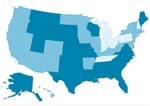Government
FDA targets medication errors by requiring bar codes on drugs
■ The rule eliminates a major hurdle to improving patient safety.
By Markian Hawryluk — Posted March 15, 2004
- WITH THIS STORY:
- » Related content
Washington -- The government hopes a new regulation requiring bar codes on prescription drug and biological product packaging will prevent nearly 500,000 medical errors over the next 20 years. But patient safety advocates say getting hospitals to adopt bedside bar code technologies might not be so black and white.
"Bar codes can help doctors, nurses and hospitals make sure that they give their patients the right drugs at the appropriate dosage," said Health and Human Services Secretary Tommy Thompson. "By giving health care providers a way to check medications and dosages quickly, we create an opportunity to reduce the risks of medication errors."
It also could help to limit physician liability, said Scott Wallace, CEO of the National Alliance for Health Information Technology, Chicago.
"Physicians get pulled into litigation and have other problems with medication administration errors whether or not they're really their fault," he said. "This rule will eliminate those, or at least significantly reduce them."
Manufacturers will have two years to add bar codes to products already approved by the Food and Drug Administration but will have to add the codes to new products within 60 days of FDA approval.
To date, fewer than 2% of hospitals have implemented bedside bar coding systems, but many of those have documented significant cuts in errors. The Dept. of Veterans Affairs piloted a bar code system in its Comerly O'Neil Medical Center in Topeka, Kan., in 1994. That achieved an 86% reduction in medication errors over five years. No drug errors occurred when the system was used as designed.
The American Medical Association said these types of technological improvement are key to providing patients with the best possible care.
"It is our hope that, by using the proven technology of scannable bar codes, we will be able to significantly reduce medication errors," said AMA President-elect John C. Nelson, MD. "The incorporation of scannable bar codes on medications is an excellent first step to ensure that patients receive appropriate drugs and dosage."
The FDA opted to exempt product samples that are used primarily in physician offices, which the agency said are unlikely to make use of bar code technology. But patient safety experts say the FDA rule will remove a major impediment to widespread adoption of bar code systems by hospitals, nursing homes, ambulatory surgery centers and other facilities.
"It's been really the classic chicken-and-the-egg example," said Jeff Schou, director of health care for Symbol Technologies, a health care information technology vendor in Holtsville, N.Y. "Hospitals wouldn't put in the equipment because there weren't enough medications with bar codes on them. Pharmaceutical companies, on the other hand, were not willing to incur the additional cost of altering the manufacturing process and putting bar codes on unit-dose levels because there weren't enough hospitals that would use them."
Now hospitals that come up with the estimated $1 million to implement a bar code system can get a return on their investment in months, he said.
"We're viewing this as an absolutely huge uptake in adoption by hospitals across the country," Schou said. "We're estimating that in three to five years, 80% of the country's hospitals will have a system installed."
Technology costs still a concern
But hospitals still face a number of major barriers to implementation of bar code systems.
"Clearly, one of the other hurdles is the dollars that it takes to invest," said Nancy Foster, senior associate director of health policy for the American Hospital Assn. Even many hospitals that could afford systems were hesitant to invest without a single bar code standard.
"It's hard to think about purchasing an information technology if you're not sure it will work with all the different products coming into your hospital," she said. "This helps overcome some of the hurdles, but not all."
The regulation's effectiveness will be undermined somewhat because drugs frequently are not packaged in unit doses, some experts said. Hospitals need bar codes on individual doses that can be scanned at the patient's bedside to effectively prevent medication errors.
Some patient safety groups had pushed the FDA to include a mandate that manufacturers provide prescription drugs packaged in individual dosages, but the agency said it did not have the authority to dictate how manufacturers package their goods.
Under the rule, the bar code needs to go only on whatever container of medication goes into the hospital pharmacy from the manufacturer, said Peter Mayberry, executive director of the Healthcare Compliance Packaging Council, a trade group of companies that provide packaging materials and machinery for pharmaceutical products.
"As soon as those pills go out of the bottle, they are separated from their bar code, meaning there is no ability for the nurse to scan the bar code and the patient's wrist band at the bedside," he said.
Larger hospitals can invest in robotic systems to repackage prescription drugs with no risk for human error, said Michael Cohen, president of the Institute for Safe Medication Practices, in Huntingdon Valley, Pa. But smaller facilities might not be able to afford that option. Cohen also is concerned that manufacturers who do package some drugs in unit doses might stop doing so because they find it too costly to add bar codes.
"There are many of us who are extremely concerned that the industry might find this costly enough that they would drop a currently available medication that is in unit-dose packaging," he said. "We rely on that unit-dose packaging for almost all inpatient dispensing. I worry that in the long run, if we don't have that, we could have more errors."
A number of distribution companies offer repackaging services for hospitals that provide unit-dose packaging with bar codes, but hospitals still must purchase the bar code scanners and the necessary software.
Hospitals can recoup that investment through the prevention of adverse drug events that could lead to longer hospitals stays, more lab tests, costly investigations and potential litigation, said Mary Beth Navarra, RN, director of medication safety for McKesson Corp., Pittsburgh.












